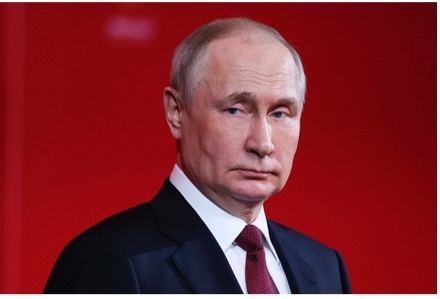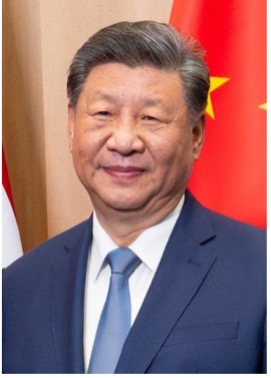by Barry Briggs
The world has changed over the past decade. Not long ago, international politics was dominated by the United States and supported by smaller, but wealthy countries with Western democratic values. Now the power and influence wielded by the US and its allies is in decline – a decline, I argue, is accelerating.
Power hates even the hint of a vacuum. Two countries – Russia and China – whose interests and values are inimical to those of the West are assuming their place in a new tripartite world. In different ways they seek to extend their power across the globe while suppressing, violently in many cases, the rights and freedoms of individuals and whole minority groups.
Russia
In 2005, Russian President Vladimir Putin famously told an audience that the fall of the Soviet Union “was the greatest geopolitical catastrophe of the century.” It’s an obvious conclusion that the attempted invasion of Georgia in 2008, the annexation of the Crimea in 2014, and the current, disastrous war in Ukraine are all part of a larger plan to restore the USSR.
However, it’s my view that Putin – an extremely intelligent, cunning leader – seeks rather to emulate the 17th century Tsar Peter the Great, whom he frequently mentions in speeches. Peter, who ruled as an absolute monarch for 43 years, was a brilliant polymath credited with modernizing backwards Russia – and expanded its borders both east and west. Peter is Putin’s role model.
But Putin is not mired in the past. He is a modern man well versed in current technologies, as this remarkable dialog with PhDs and postdocs in St. Petersburg a few years ago demonstrates. And his five-hour end-of-year press conferences (most recently, here) much of which are ad lib interactions with journalists demonstrate clear, perhaps unmatched among leaders, intellectual agility.
However, Putin, a former KGB agent, is – frankly – hamstrung by his abject hatred of the West and in particular of the United States. He, and most Russians, hold the US responsible for the collapse of the USSR, and while most Americans believe the Cold War over, Putin and Russia see the USSR’s downfall only as a setback. The war continues. That then-Secretary of State Hillary Clinton attempted, in Putin’s view, to interfere with the 2014 Russian elections was for him unforgivable, and continued evidence of America’s desire to weaken Russia – and Putin.
Putin’s strategy toward world and Russian affairs, then, can be summed up as follows:
- Expand Russia’s borders either directly or with client states to buffer against the US-dominated NATO alliance. Hence the war in Ukraine; and all sorts of mischief in Eastern European countries.
- Expand trade with friendly non-Western nations such as China, India, Turkey, North Korea and Iran. Russia’s massive oil and gas reserves, once supplying the bulk of energy to Europe, are now being redirected. Russia needs this infusion of cash to both support its war in Ukraine and to reduce the crushing inflation (central bank rates are 21%!) at home.
- Crush all opposition internally – as did Peter the Great, all the other Tsars after, and for that matter the Communist rulers. Putin – and many Russians – believe that Gorbachev, a reforming Westernizer, caused the USSR to fall while Stalin, a brutal dictator, made the USSR “strong.”
- Use any and all methods short of war to weaken and disrupt the United States. In this I believe Putin has been remarkably successful by using such means as social media to divide Americans and to manipulate the election of the US president of his choice. To be clear, Putin’s goal is less a Republican consensus, but rather a weakened, divided, polarized – and paralyzed – America. More on that later, but suffice it say, as I did in this blog post, it’s not that hard, sadly.
Militarily, it is notable that the Ukraine war has depleted the Red Army and other branches – significantly, perhaps up to one million casualties. But Russia’s losses have been China’s and North Korea’s gains as both have supplied Moscow.
Finally, in any calculus involving Russia, its huge stocks of nuclear weapons must be taken into account. Several thousand Russian nuclear warheads on a hair trigger target the United States. Let’s not forget that history could end in the space of just a few minutes.
China
Two or three decades ago we hardly considered China a threat. Now, both militarily and economically, it presents the biggest challenge to the United States and to our way of life perhaps in our history.
I remember in the 1970s, shortly after Nixon “opened” China, a conversation I had with a fellow who planned to get rich by selling to China. What goods was he planning to sell? Nails. And screws. The most basic construction materials.
Fast forward to the present: Shanghai is perhaps the most modern city on Earth; BYD sells more electric cars than any other company; the Chinese navy boasts more ships than that of the US. It is a truly stunning transformation driven by an economic philosophy completely antithetical to ours: centrally managed development, a planned economy, that – unlike the failed “5-year plans” in the USSR – succeeded beyond expectations. After the chaos and repression of the Cultural Revolution and Great Leap Forward, China actually has leapt forward, and quite far.
Just check out the explosive growth of Chinese high-speed railroads in just 12 years, far surpassing rail progress in the US — or anywhere in the world:

Xi Jinping’s ambition, simply put, is global domination through nonviolent means. For all its investment in the People’s Liberation Army (over two million active serving personnel in ground, naval, air, and rocket forces), China has not engaged in armed conflict since the end of the Korean War in 1953 – whereas the US and Russia, for better or worse, both have experienced, battle-hardened militaries.
Instead, China views economics as its principal weapon. Its so-called “Belt and Road Initiative,” announced in 2013 and now reputedly the largest foreign aid project since the post-WWII Marshall Plan, has invested in well over 140 countries. Over 75% of the world’s population has been affected by BRI in one form or another. Either through loans or outright grants China has helped countries build bridges, modernize ports, and constructed railroads: these multi-billion-dollar infrastructure projects extend China’s influence in Vietnam, Cambodia, Indonesia, Italy, and Greece – not to mention large-scale projects in the Americas, in Peru (deep-water port), Ecuador, and Brazil, to name a few. The influence China gains from these foreign investments cannot be understated.
Internally China’s technology innovation thrives, not least because of significant IP theft which helped it leapfrog early mistakes (as my friend Evan Anderson has documented extensively). Countless examples of copycat technology from computers to missiles and jet aircraft exist. Taking advantage of cheap labor – at least until recently – China has flooded the West and especially the US with inexpensive goods: it is estimated between 70% and 80% of goods in Wal-Mart and Amazon are Chinese-built.
Nevertheless, there are problems: China massively overbuilt housing through the 2010s; over 20% of its workforce is still agricultural, far above other developed countries; and its surveillance-happy, repressive government keeps close tabs on its citizens. However, unlike Russia and the US, inflation remains at near zero, if we are to believe its economic reports.
United States of America
Turning inward, the US appears to be abandoning its global leadership role. While its foreign policy seemed to stabilize somewhat during the Biden administration, it is, at this writing, in flux to put it kindly; “chaotic” might be a better word. Harsh words and tariffs on its allies, kowtowing to its enemies, specifically Russia: it’s difficult to understand what America’s global vision, if any, is.
The ”America First” slogan, eerily reminiscent of the exact same words used in the 1930s as the US turned a blind eye to events in Europe and Asia – which of course led to World War II (the photo shows Charles Lindbergh addressing an America First rally) – has turned Americans against one another. As Germans were encouraged to report Jews in the early days of the Holocaust so too are Americans asked to report illegal immigrants, and to not help them by informing them of their rights. Whole government agencies are being disbanded and regulations – protections by any other name – are struck from the Federal Register.
By cutting foreign aid funding, the Trump administration has essentially opened the door to further Chinese investment worldwide. The Pacific and the Indian Ocean will become, economically, Chinese lakes.
By abandoning Ukraine, the Trump administration emboldens Putin’s imperialistic actions, risking the invasion of a host of former Soviet republics: Georgia, Moldova, perhaps even Poland. And what is after that? Germany? France? Moreover, should Russia win a victory in Ukraine, then every country in the world would recognize that American security commitments are worthless – thus driving them to other guarantors, namely China or Russia.
All that having been said, for the moment at least the American economy remains the strongest in the world. All other currencies measure themselves against the dollar. America leads the world in technological innovation, even as China and others copy it as quickly as we create it. Referring to their own stagnant economies, European investors talk about “American exceptionalism” and recommend the US stock market over their own bourses.
Both Russia and China believe the US freedoms will be its downfall – and are committed to it. Thus, both have engaged in massive covert disinformation campaigns – largely successful – to divide Americans, to stir distrust of the American government, and to elect leaders who promise to dismantle it. This is precisely what Putin and Xi desire.
The aggressive, authoritarian, even dictatorial philosophies of Russia and China are absolutely opposed to the American way of life – and are committed to its downfall. To ignore this plain-as-day truth is to accelerate our defeat.
The Tripartite World
This is now the world we live in, in which the primary competition – economically, intellectually, militarily – is between the US, Russia, and China.
Other countries and regions, bluntly, do not matter as much. They are chess pieces manipulated in the grand three-way battle.
India refused to back Ukraine and instead began purchasing oil from Russia, incurring the wrath of the West. Trump’s generally more transactional approach and in particular recent entreaties to Russia may however signal a change.
India’s foreign policy remains one of studied nonalignment (Prime Minister Modi calls it “multialignment,” which is essentially the same thing), focusing more on the more pressing regional issue of its nuclear-armed rival Pakistan – with whom armed conflict always seems imminent.
Internally, India’s internal policies remain concerning. The Indian government has ramped up repressive actions against its Muslim minority. Violence is common and increasingly the authorities turn a blind eye.
Nevertheless India remains economically tied to the US. The two countries have formed an interdependence: US industries – in particular, IT – heavily rely on the likes of Infosys, Tata, Cognizant, HCL, and others.
Europe, long stagnant, may be awakening as a consequence of America’s new isolationism. Several, recognizing the threat from Russia (and the obvious parallels with 1939), have announced increased military support for Ukraine. A wave of European rearmament appears to be on the horizon.
However, the far right continues to expand across Europe, partially in reaction to wave of Syrian immigration in the mid 2010s (nearly a fifth of Syria’s pre-civil war population found their way to Europe). In Germany, the Alternative for Germany (AfD) enjoyed unprecedented gains in recent elections. Marie le Pen’s far-right National Rally won a clear majority in the first round of last summer’s elections in France only to fall short in the second. Fidesz, Hungary’s ruling party, won on a populist and anti-immigrant platform.
Growth remains slow. GDP rises for the UK, France, and Germany are all projected at less than 1% in 2025 (compared to 5% for China).
The Middle East continues to roil with no end in sight. The damage to both Israel and Palestine from the vicious October 7th attacks and the brutal, if deserved, retaliation will linger for generations. For the US, Israel represents an outpost of Western democratic and individualistic values in a troubled region; while it continues to be in American interests to support Israel, the Jewish state has demonstrated – time and again – it is well capable of taking care of itself.
Iran remains an existential threat to both Israel and secondarily the US. By abrogating the agreement limiting Iran’s production of enriched uranium, Trump in his first term effectively allowed that country to proceed apace with nuclear weapons development. The assassination of Qasem Soleimani, effectively Iran’s number-two leader, by a US drone in 2020 (also on Trump’s order) likely eliminated any possibility of renegotiation.
Africa, South and Central America remain strategically important to the US, especially as both China (with the Belt and Road Initiative) and Russia (with the brutal Wagner Group) are making inroads. Central Africa in particular poses a challenge to global stability: impoverished, dispossessed – and unhappy – males in their 20s comprise the majority of its population, leading to the possibility of multiple failed states in the region. The West African nation of Niger, which after a coup strengthened ties with Russia, recently expelled a US anti-terrorism military force stationed there.
Trump, under the Rasputin-like influence of South African immigrant billionaire Elon Musk, alienated that otherwise neutral country by offering its Afrikaner (white) residents asylum in the US for no particular reason. The State Department then subsequently expelled Pretoria’s ambassador for a speech in which he claimed the US was pursuing white supremacist policies – arguably correct.
Meanwhile, South Africa was the first to sign a Belt and Road partnership with China, which to date has invested some $25 billion there.
China has also invested in Costa Rica, Nicaragua, and Panama in Central America. Nicaragua, in a clear sign of Chinese influence, severed relations with Taiwan. Numerous countries in South America have benefited from the Belt and Road Initiative, including Uruguay, Argentina, Chile, Venezuela, Ecuador, and Peru.
Whether or not these countries ever pay China back is irrelevant. China now owns these chess pieces.
Who Will Win?
The rise of Russian and Chinese influence across the globe with the coincident decline of America on the world stage is troubling, to say the least. Americans’ polarization and self-absorption, their obsession with silly cultural issues, their distrust of their own government, and the fact that they take their freedoms for granted are all leaving the world open to other more sinister powers.
As I’ve stated, China and Russia want nothing less than the utter destruction of the American way of life. It is a top-level strategic objective for both countries.
How can we survive?
First, we must resume our leadership position in the world. Soft power is important. This means resuming generous foreign aid, investing in other countries, providing medical services around the world (in particular, Africa, to stem the tide of HIV and malaria) and assuming, again, moral leadership by calling out dictators and repressive regimes. This is a core vision that every US president from Carter to Reagan to Bush to Clinton shared.
Second, the US must invest in education at home. The confrontation between three powers will not be decided on the battlefield but by smart, clever people – on the diplomatic front, on the financial front, and on the technological front.
Thomas Jefferson once wrote, “Whenever the people are well-informed they can be trusted with their own government.” Yet, appallingly, a large percentage of the American populace cannot name the three branches of government. The federal government should assume authority over the curriculum of our public schools, not for any ideological reason, but so that our kids can compete in the world.
Third, the American budget must be reprioritized. I do not dispute the importance of hard military power — but we have overinvested. We prioritize some 66 nuclear attack submarines (at a cost approaching a half a trillion dollars) over feeding hungry children and ensuring their – and everyone’s – health and well-being. Could we get by with (say) 40 attack subs and feed and educate our kids?
A New World Order
This new world order is characterized by white-hot competition among the three superpowers. China seeks economic dominion; Russia wants to re-establish the USSR; all while the complacent United States declines and withdraws. Even worse, the US appears to be in a state of intellectual collapse, not recognizing or even wanting to recognize, the dangerous world around it.
History does not repeat itself. Yet one cannot help but compare our time to previous ones: what will be the Sudetenland or the Poland that trips the world into another cataclysm?






